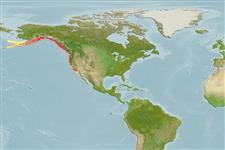Preferred temperature (Ref.
115969): 4.5 - 8.9, mean 5.9 (based on 177 cells).
Phylogenetic diversity index (Ref.
82804): PD
50 = 0.5000 [Uniqueness, from 0.5 = low to 2.0 = high].
Bayesian length-weight: a=0.01000 (0.00499 - 0.02004), b=3.09 (2.92 - 3.26), in cm Total Length, based on LWR estimates for this Genus-body shape (Ref.
93245).
Trophic level (Ref.
69278): 3.5 ±0.46 se; based on food items.
Resilience (Ref.
120179): Low, minimum population doubling time 4.5 - 14 years (tm=4; tmax=50; Musick et al. 2000 (Ref.
36717)).
Prior r = 0.25, 95% CL = 0.17 - 0.38, Based on 1 stock assessment.
Fishing Vulnerability (Ref.
59153): High vulnerability (63 of 100).
Climate Vulnerability (Ref.
125649): Moderate to high vulnerability (45 of 100).
